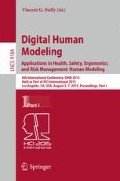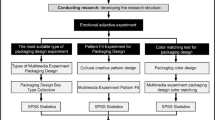Abstract
In this paper, “The way of tea” process conducted by expert, non-expert and beginner was investigated. Firstly, final tea made by expert, non-expert and beginner applying three kinds of tea whisks were taken into photos. Afterwards, random ranked tea photos were employed as visual evaluation questionnaire and subjective ranking material. In order to compare and characterize “The way of tea” process difference, 10 Japanese and 10 Chinese participates were chosen as evaluation subjects. Consequently, it can be concluded that both Japanese and Chinese are able to distinguish expert’s tea as top rank easily because of sufficient small bubble size on the tea surface.
You have full access to this open access chapter, Download conference paper PDF
Similar content being viewed by others
Keywords
1 Introduction
“The Way of Tea” is called the “Japanese tea ceremony”, which is a special ceremonial art preparation and presentation of “Matcha”(a kind of green tea powder) to entertain the guests, through the tea ceremony people will achieve temperament, improve the cultural quality and aesthetic view. The essence of “The Way of Tea” is meant to demonstrate reverence and respect between host and guest, both of them can truly experience the artistic conception and taste the most primitive taste of green tea during tea-tasting activity and service process with the tallest state of the etiquette.
“Urasenke” is one of the three main genres of “Japanese tea ceremony”, which is derived from “Sen-Rikyu”. The other two main genres are “Omotesenke” and “Mushakojisenke”. The different tea genres have different tea making skills after diversified development. However “The Way of Tea” of each genre is consisted of many specific and strict procedures, whose basic skill just only handed over by oral instructions by expert.
Therefore, in order to create a favorable atmosphere between the tea master and guest the tea masters have to study and practice for a long time to master and understand the whole tea ceremony. However, until now the scientific evaluation for the process analysis of “The way of tea” is limited. But above all, it’s very difficult for every master to inherit the essentials of tea ceremony essentials to the next generation without an effective way.
In this research, expert, non-expert with different experience years and beginners were employed as the behavior subjects. The three types of different tea whisks as the same with previous research, “Yabunouchi”, “Kankyuan”, “Ensyu” were used to make tea. Through visual perceiving directly on final product, we would like to clarify the relationship between bubble distribution/size and process characterization.
As well known, no matter use what kind of tea whisks, the final bubble distribution was one of most important features for a tasty tea, which depend on the bubble size, distribution and so on. On the other hand, the bubble forming process was also reflected the characteristics of the tea whisks’ performance. It is notify that expert can master the performance of three types of tea whisks than non-expert and beginner, and made excellent cups of tea with sufficient small bubble. Therefore, evaluation subjects were easily to distinguish the tea photos of expert and then give a high rank.
In a word, the purpose of this study is through visual evaluation to clarify “The way of tea” process characteristic in order to provide a suggestion to help learner easier to understand and keep the perfect tea impression in mind (Fig. 1).
2 Experiment
2.1 Participants
A Japanese tea master (expert), a non-expert and four other beginners from Kyoto were employed as the tea conductor participant. Especially, expert participant had more than 30 years experience in “the way of tea”, who can keep the motion of scooping water and ensure the added water weight in the bowl nearly the same for each tea making process.
2.2 Evaluation Subjects and Objects
Three types of Japanese tea whisks were prepared for participants to make the tea as “Yabunouchi”, “Kankyuan”, “Ensyu”, which were the three most popular tea whisks in Japan as shown in Fig. 2. And the made teas were taken into photo and 15 pieces were used for following visual evaluation process. Finally, 10 Japanese and 10 Chinese were required to asset the tea and give a total rank.
2.3 Experimental Process
Every participant was required to make 3 cups of tea by previous three kinds of tea whisk one by one, during the process 1.5 g of “Matcha” tea power and approximate 56 g of hot water were dumped into the bowl following with hard mixing behavior, and finished tea were taken into photo by single-lens reflex camera (D40x Nikon CO. Ltd) immediately to record the bubble distribution and bubble size on the tea surface. Selected tea photos for visual evaluation were illustrated in Fig. 3.
3 Results and Discussions
As illustrated in Fig. 4, ranked tea photos in top 3 and bottom 3 were voted by 20 evaluation subjects landside. Comparing with rank bottom 3 group, rank top 3 group showed lighter tea green color with rich and creamy small bubbles on the surface. On the opposite, bottom rank 3 group showed dark green color with inconformity bubble size.
3.1 Tea Aesthetic Comparison Between China and Japan
Japanese tea ceremony originated from China, which has its own formation, development process and specific connotation with the charming of oriental culture. Learning tea ceremony could cultivate people’s aesthetic and moral values. According to the rank of tea photos, both Chinese and Japanese evaluation subjects showed the same vote of top 3 and bottom 3 groups. It was consider that tea culture and tea aesthetic were same between two countries even along with spreading, so the tea process characteristic also can be concluded to be the same.
3.2 Tea Whisk Comparison Between Yabunouchi, Kankyuan and Ensyu
According to the summarized results in Table 1, it is obvious to find that expert’s tea made by Yabunouchi was ranked higher than Kankyuan and Ensyu. The shape was different from three kinds of tea whisks, based on previous study conclusion, the tea whisk of “Yabunouchi” was presented the wider distribution of small bubbles. And bubbles made by “Kankyuan” and “Ensyu” were almost concentrated in the range of 0.2~1 mm2. In a word, the bubbles showed smaller size after mixing by applying “Yabunouchi” tea whisk. Therefore, it is clarified that tea made by Yabunouchi with smaller bubble size could be accepted and favored by larger numbers of people.
3.3 Easy Identification of Expert’s Tea During Visual Evaluation
Based on the counting results of ranked photos, it is obvious to find that except top 3 and bottom 3 groups other tea photos identification is very difficult for subjects evaluation, therefore, middle rank tea photos showed variable votes. However, expert could master skillful technique to make tea by any kind of tea whisk and produce richer and smaller bubbles on tea surface. So expert’s tea has easy identification with obvious characteristics, which help for visual evaluation.
3.4 The Influence of Bubble Size and Distribution for Visual Evaluation
As showed in Fig. 5, vote people number for ranked tea photos were listed clearly. It is worthwhile to note that top 3 and bottom 3 ranked photos were voted with nearly over half of total people, however vote number for the middle rank tea photos is less and lack of persuasion. That is to say, people subjects were easily to identify the best and worst but difficult to judge the middle rank. As previous discussion, bubble size in ranked tea photos upper ones had smaller bubble on tea surface, which obtained better confirmation from evaluation subjects. It demonstrated that when bubble fineness reaches to a certain limit could support beauty assessments directly. In other words, expert is able to make rich small bubbles on tea surface stable, so evaluation subjects could easily identify expert’s tea. However, non-expert could not keep stable tea making technique, and beginner do not understand the bubble making technique and its important points. So during visual evaluation, their teas product photos are difficult for identification.
4 Conclusions
In this paper, process analysis on technique of “The way of tea” was investigated by visual analysis on expert, non-expert and beginner’ tea work. It is found that expert’s tea was easier to be ranked in the top with obvious tea bubble characteristic. Furthermore, tea whisk’s behavior was also clarified that Yabunouchi could produce more fitness bubble and obtained more people’s favor. In a word, when bubble fineness reaches to a certain limit tea work was easier to be evaluated and confirmed directly.
References
Tujimoto, N., Ichihashi,Y., Iue, M., Ota, T., Hamasaki, K., Nakai, A., Goto, A.: Comparison of bubble forming in a bowl of thin tea between expert and non-expert. In: Proceeding of 11 th Japan International SAMPE Symposium and Exhibiton (2009)
Goto, A., Endo, A., Narita, C., Takai, Y., Shimodeand, Y., Hamada, H.: Comparison of painting technique of Urushi products between expert and non-expert. In: Advances in Ergonomics in Manufacturing, pp. 160–167 (2012). ISBN: 978-1-4398-7039-6
Aiba, E., Kanazawa, S., Ota, T., Kuroda, K., Takai, Y., Goto, A., Hamada, H.: Developing a system to assess the skills of japanese way of tea by analyzing the forming sound: a case study. In: Human Factors and Ergonomics Society International Meeting. (2013)
Author information
Authors and Affiliations
Corresponding author
Editor information
Editors and Affiliations
Rights and permissions
Copyright information
© 2015 Springer International Publishing Switzerland
About this paper
Cite this paper
Kanazawa, S. et al. (2015). Visual Evaluation of “The Way of Tea” Based on Questionnaire Survey Between Chinese and Japanese. In: Duffy, V. (eds) Digital Human Modeling. Applications in Health, Safety, Ergonomics and Risk Management: Human Modeling. DHM 2015. Lecture Notes in Computer Science(), vol 9184. Springer, Cham. https://doi.org/10.1007/978-3-319-21073-5_30
Download citation
DOI: https://doi.org/10.1007/978-3-319-21073-5_30
Published:
Publisher Name: Springer, Cham
Print ISBN: 978-3-319-21072-8
Online ISBN: 978-3-319-21073-5
eBook Packages: Computer ScienceComputer Science (R0)









